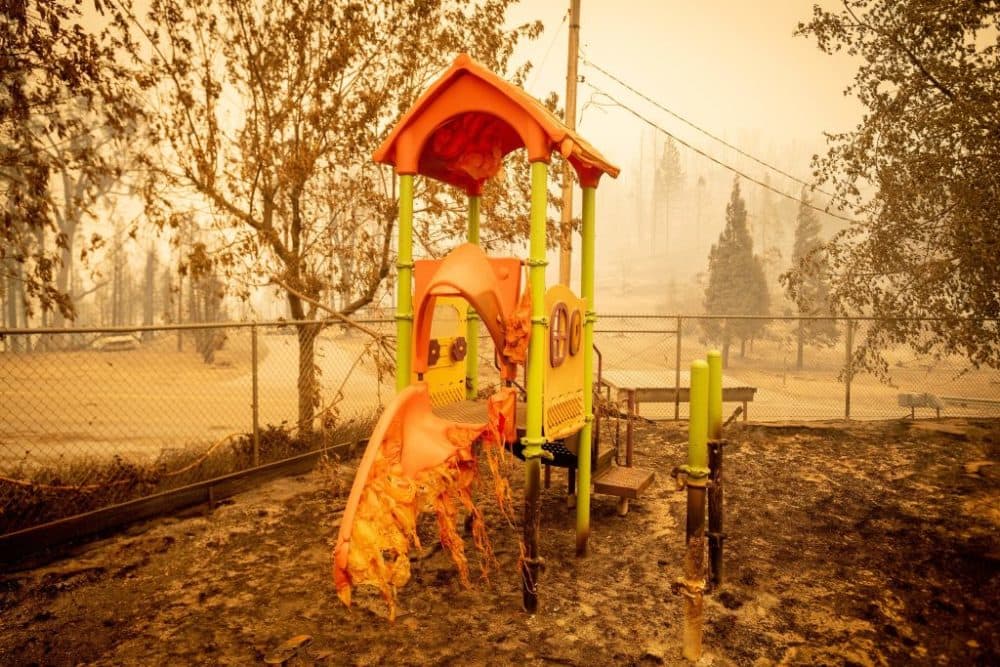Advertisement
California School Principal Who Lost His Home To Creek Fire Says He’s Living In A 'New Reality'

In the dark hours of the morning on Saturday, Toby Wait and his family packed their Subaru and drove out of Big Creek, California. A caravan of neighbors, with trailers and boats in tow, made their way along the narrow road cut into the side of a cliff, the only route out of town.
As they evacuated, Wait told his wife and children that he thought they would return home within 24 hours.
But the Creek Fire followed on their heels. The flames tore through the 200-person town and destroyed half the homes, including Wait’s house.
“The initial reports were that our entire community was gone,” he says, speaking with Here & Now from his relatives’ house south of Fresno, the nearest big city. “Hearing that news was devastating.”
When the smoke cleared, firefighters relayed more accurate information. As many as 30 houses had burned down, Wait estimates, but the K-8 school where he works as principal had survived. He spent the next few days calling up parents, who had scattered to family homes and hotels across the state and as far away as Colorado.
“The school is the centerpiece of our community,” he says. “That gives people hope. That's what we're clinging to right now.”
The Creek Fire started on Sept. 4, as dry weather and record-setting temperatures over Labor Day weekend fanned fires across the West, including two of the largest fires in California’s history. In total, a record-shattering 3.1 million acres have burned across California this year, nearly 1 million in the past few days alone.
But as fires up and down the coast fill the air with ash, warp wind-patterns and turn skies bright orange, the Creek Fire has posed an especially daunting challenge for firefighters. Crews have struggled to contain the fire as it races across the rugged terrain of the Sierra National Forest, burning more than 175,000 acres. A week after the first spark, the fire remains just 6% contained.
The residents of Big Creek were some of the earliest people to flee the fire, but some 45,000 others have followed over the past week. And while at least 14 people have died so far from fires raging along the West Coast, there are no reports of deaths in Big Creek.
Advertisement
“Listen, we’re not victims,” Wait says. “We’re gonna make it.”
Wait describes the town that was destroyed with some reverence: he talks about a company town, where life revolves around the Southern California Edison hydroelectric plant, kids ride their bikes in the dark, and neighbors gather for movie nights and potlucks. He mourns its loss, and he’s angry at local and state officials for what he sees as a massive failure to manage the land and forests appropriately.
But he tells his kids, and families from the school, to focus on what they have, not what they’ve lost.
“Our reality has changed,” he says. “And what we make of that new reality is completely up to us.”
As he looks forward to Big Creek’s new reality, Wait is spending a lot of time thinking about the town’s past. He moved to Big Creek just a decade ago, but his family has deep roots in the area: his grandfather rode a train into town in 1929 and stayed, and his father was born there. When the principal post at the local 55-student school opened up, Wait jumped at the chance to move.
“If you were to tell me I’d leave with the shirt on my back,” he says, “I’d do it all over again.”
On Thursday, he returned home for the first time since the fire, where he found keepsakes among the ashes that he never thought he would see again: half an ornament from the first Christmas he spent with his wife, scattered pieces of a nativity scene that his grandmother had built.
He also returned to the school, which suffered mostly “cosmetic” damages. The fire blew out the windows, and a thick layer of ash settled across the floors. The fire also destroyed four of the six houses that the school owns, which means that many of his employees have lost homes too.
The school was supposed to restart in-person learning after Labor Day. Now Wait doesn’t expect their doors to open until next spring at the earliest. But despite the pandemic and the fire, Wait says virtual learning is still on.
“School starts Monday morning, 8:30,” he says. “And I expect them to be there, ready to go.”
This segment aired on September 11, 2020.

